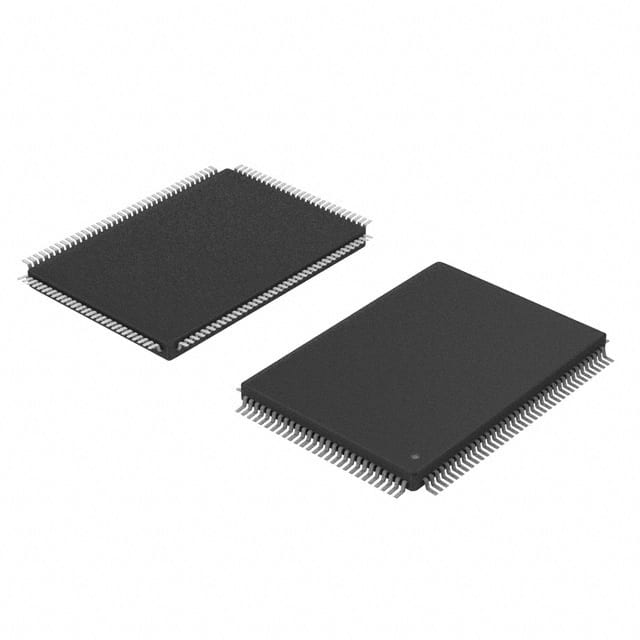AT91SAM7SE256-AU-999
Product Overview
Category
AT91SAM7SE256-AU-999 belongs to the category of microcontrollers.
Use
This microcontroller is commonly used in various electronic devices and embedded systems.
Characteristics
- High-performance 32-bit ARM architecture
- Clock speed of up to 55 MHz
- Flash memory capacity of 256 KB
- RAM capacity of 64 KB
- Multiple communication interfaces (UART, SPI, I2C)
- Analog-to-digital converter (ADC)
- Timers and counters for precise timing operations
- Low power consumption
- Wide operating voltage range
Package
AT91SAM7SE256-AU-999 is available in a compact surface-mount package.
Essence
The essence of this microcontroller lies in its ability to provide efficient processing power and versatile connectivity options for various applications.
Packaging/Quantity
AT91SAM7SE256-AU-999 is typically packaged in reels or trays, with quantities varying based on customer requirements.
Specifications
- Architecture: ARM7TDMI-S
- Clock Speed: Up to 55 MHz
- Flash Memory: 256 KB
- RAM: 64 KB
- Operating Voltage: 1.65V to 3.6V
- Communication Interfaces: UART, SPI, I2C
- ADC Resolution: 10-bit
- Timers/Counters: 6
- GPIO Pins: 53
- Operating Temperature Range: -40°C to +85°C
Detailed Pin Configuration
The AT91SAM7SE256-AU-999 microcontroller has a total of 100 pins. The pin configuration is as follows:
- Pin 1: VDDIO
- Pin 2: PA0
- Pin 3: PA1
- ...
- Pin 100: GND
For a complete pin configuration diagram, please refer to the datasheet provided by the manufacturer.
Functional Features
- High-Performance Processing: The ARM7TDMI-S architecture ensures efficient execution of instructions and enables fast data processing.
- Versatile Communication Interfaces: The UART, SPI, and I2C interfaces allow seamless integration with other devices and enable data exchange.
- Analog-to-Digital Conversion: The built-in ADC facilitates accurate conversion of analog signals into digital values for further processing.
- Timers and Counters: The microcontroller offers multiple timers and counters, enabling precise timing operations and event management.
- Low Power Consumption: The AT91SAM7SE256-AU-999 is designed to minimize power consumption, making it suitable for battery-powered applications.
- Wide Operating Voltage Range: The microcontroller can operate within a wide voltage range, providing flexibility in various power supply scenarios.
Advantages and Disadvantages
Advantages
- Powerful processing capabilities
- Versatile communication options
- Efficient analog-to-digital conversion
- Precise timing operations
- Low power consumption
- Wide operating voltage range
Disadvantages
- Limited flash memory capacity compared to some other microcontrollers in the market
- Relatively higher cost compared to entry-level microcontrollers
Working Principles
The AT91SAM7SE256-AU-999 microcontroller operates based on the ARM7TDMI-S architecture. It executes instructions fetched from its flash memory and performs various tasks according to the program loaded onto it. The microcontroller communicates with external devices through its UART, SPI, and I2C interfaces, enabling data transfer and control. It also utilizes its analog-to-digital converter to convert analog signals into digital values for processing. The timers and counters facilitate precise timing operations, allowing synchronization with external events. The microcontroller's low power consumption and wide operating voltage range make it suitable for a wide range of applications.
Detailed Application Field Plans
The AT91SAM7SE256-AU-999 microcontroller finds applications in various fields, including but not limited to:
- Industrial Automation: Control systems, motor control, and monitoring devices.
- Consumer Electronics: Smart home devices, wearable technology, and multimedia systems.
- Automotive: Engine management systems, dashboard displays, and vehicle diagnostics.
- Medical Devices: Patient monitoring systems, medical imaging equipment, and diagnostic tools.
- Internet of Things (IoT): Connected devices, sensor networks, and data acquisition systems.
- Robotics: Robot control systems, motion control, and autonomous navigation.
Detailed and Complete Alternative Models
- ATmega328P: A popular microcontroller with similar capabilities, widely used in Arduino boards.
- STM32F103C8T6: Another ARM-based microcontroller offering high performance and rich peripheral options.
- PIC18F4550: A microcontroller from Microchip with USB connectivity and ample I/O capabilities.
These alternative models provide similar functionalities and can be considered as alternatives to the AT91SAM7
Lista 10 Vanliga frågor och svar relaterade till tillämpningen av AT91SAM7SE256-AU-999 i tekniska lösningar
Sure! Here are 10 common questions and answers related to the application of AT91SAM7SE256-AU-999 in technical solutions:
Q: What is the AT91SAM7SE256-AU-999 microcontroller used for? A: The AT91SAM7SE256-AU-999 is a microcontroller commonly used in embedded systems, industrial automation, and IoT applications.
Q: What is the maximum clock frequency supported by the AT91SAM7SE256-AU-999? A: The AT91SAM7SE256-AU-999 supports a maximum clock frequency of 55 MHz.
Q: How much flash memory does the AT91SAM7SE256-AU-999 have? A: The AT91SAM7SE256-AU-999 has 256 KB of flash memory for program storage.
Q: Can I expand the memory of the AT91SAM7SE256-AU-999? A: Yes, the AT91SAM7SE256-AU-999 supports external memory expansion through its external bus interface.
Q: What peripherals are available on the AT91SAM7SE256-AU-999? A: The AT91SAM7SE256-AU-999 includes various peripherals such as UART, SPI, I2C, ADC, PWM, and timers.
Q: Does the AT91SAM7SE256-AU-999 support USB connectivity? A: Yes, the AT91SAM7SE256-AU-999 has a built-in USB 2.0 Full Speed (12 Mbps) device port.
Q: Can I use the AT91SAM7SE256-AU-999 for real-time applications? A: Yes, the AT91SAM7SE256-AU-999 has a real-time timer (RTT) and supports interrupt handling for time-critical tasks.
Q: What development tools are available for programming the AT91SAM7SE256-AU-999? A: The AT91SAM7SE256-AU-999 can be programmed using various IDEs, compilers, and debuggers such as Atmel Studio, Keil MDK, and IAR Embedded Workbench.
Q: Is the AT91SAM7SE256-AU-999 suitable for low-power applications? A: Yes, the AT91SAM7SE256-AU-999 features multiple power-saving modes and peripherals that can be selectively powered down to minimize power consumption.
Q: Are there any application examples or reference designs available for the AT91SAM7SE256-AU-999? A: Yes, Atmel provides application notes, reference designs, and software libraries to help developers get started with the AT91SAM7SE256-AU-999 in various applications.
Please note that the specific details and answers may vary depending on the documentation and resources provided by the manufacturer of the microcontroller.


